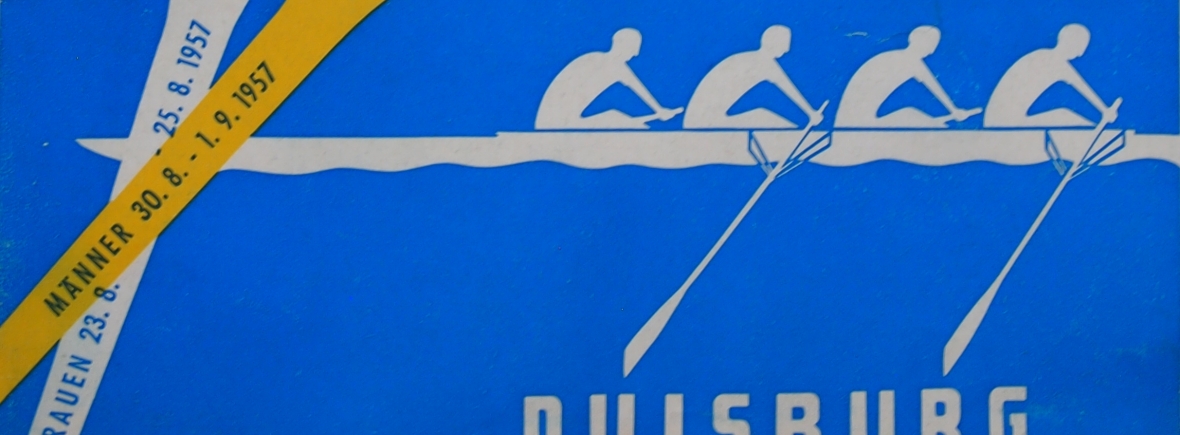The 1957 Women’s European Rowing Championships took place on the purpose-built Wedau rowing course in Duisburg, West Germany, from 23-25 August, a few days before the men’s championships which ran from 20 August to 1 September.
30 crews competed from 11 countries.
Racing was over 1,000m, the distance set by FISA when it first introduced international women’s rowing in 1951.
As Duisburg required, “A shorter and less expensive journey than was possible in the previous two years [Bled and Bucharest], the WARA determined to find the means to send any entry put forward reaching the requisite standard,” (British Rowing Almanack, 1958).
Training and selection
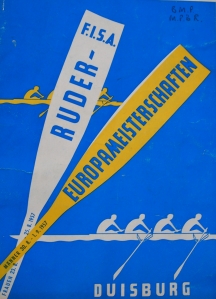
Programme cover for the 1957 European Rowing Championships
Part 1: Who’s in the eight?
The England or GB crews at the test regattas in 1951-1953 had been club crews. In contrast, for the 1954 Championships, a composite eight had selected but subsequently found it very hard to merge styles and train in a single location. This year, a hybrid approach was adopted with club crews again being selected but coaches being given the power to change one or two members, provided this was all done at least six weeks before the Championships.
WARA officials first approached the United Universities eight after they’d won the WARA Eights on 11 May. “We said, ‘No’ as there were so many difficulties,” Frances Bigg, who by this time was Captain of UUWBC, noted in her rowing scrapbook. These difficulties were twofold. First, as she and several of the other top members of the club had spent a lot of time racing their four the previous season, they felt that tht club as a whole had suffered as they had had almost no time left to spend on developing other crews. And second, largely as a result of the first, they struggled to boat a decent eight a lot of the time. “We therefore looked forward to a quiet year – rowing only for ‘fun’,” she wrote, adding “HA! HA!” in pencil later on. Readers will soon see why.
Despite their initial reluctance to put themselves forward for selection in the eight, after they’d won again the following weekend at the Lady Fletcher Eights, and had heard Freddie Page (Secretary of the Amateur Rowing Association) comment that they were the “only crew with promise”, and as they were “obviously the best,” as Frances said, “We reconsidered our previous answer when approached by WARA again. I stipulated that we must be 95% certain next Saturday [at the Borne Cup Eights] and we would consider the matter closed if we lost.”
They lost. Frances recorded what happened next:
I went to apologise to Mr Harry and he said that the Selectors wanted to see me as the conditions were a freak and they were giving our station a stagger in future. I saw the Selectors and they said that the day’s results could not be counted and I told them again how important it was that the decision must be definite (barring accidents) and they agreed – after private consultation. It was agreed that we would replace two or three people with London [University]’s best and race at Welsh Harp. Mavis [Hammond] had to drop out as she was getting married, Jane [Barlow] because her age was against her, and Bridget [Gilbert] (after a trial) became the sub. We also had to replace Goody [Jean Good, their cox] (family reasons).
Training at Arsenal FC (yes, really)
Training methods for the eight had moved on since 1954. As Dorothea Newman explains, “We didn’t have… a proper programme, but between us we did discover there was a [circuit training] course which the Central Council for Physical Recreation were running in London. It was a six-week course, once a week, so we went to that, and Arsenal Football Club, through a connection, allowed us to use their grounds for running of different kinds, and also St Thomas’s Hospital, where I trained [as a physiotherapist], had a good gym and we were allowed to use that whenever we wanted in the evenings.”
Frances Bigg noted in her training diary that, “Mr Billy Milne made some suggestions,” during the sessions at Arsenal. This was serious recognition for female athletes because Milne – who was known for his high levels of fitness when he had been player at the club – was the first team’s trainer.
The eight did four outings a week once its composition was finalised, although Gill Perry could only make three of these so sub Bridget Gilbert rowed for her in the other one. This level of practice turned out to be invaluable.
The entire crew had the first week of July off training, “To get all ‘time off’ over together and to make a break before getting down to the really tough stuff,” Frances noted. Although it was Henley week, she spent the time on a canoeing course at Bisham Abbey.
From 15 July onwards the eight trained on the non-tidal Thames at Kingston RC but, surprisingly, didn’t row at weekends there because of river traffic, according to Frances Bigg’s notes. At least the light evenings were long at that time of year.
Part 2: Confirming the eight is fast enough and choosing a coxed four
No other eight was in the running, but the UU crew still had to do a time trial over the 1,000m course on the Desborough Cut in Weybridge on 27 July (and yes, that is less than a month before the event). Frances wrote in her training diary that the Selectors “sprang” this requirement on them with a fortnight’s notice. “We pointed out that we weren’t ready to race, and after considerable worry, upset and argument they agreed to accept a row-over at 28 – with pairings [i.e. pace boats].”
The eight rowed over in a time of 3’56”, while a Stuart Ladies four beat a crew from Weybridge Ladies ARC by two and a half lengths in 4’26”.
The selectors (Amy Gentry, Eleanor Lester, Maud Cann, Margaret Barff and Marjorie Lutz) felt that these times were sufficiently fast, in comparison with times taken at the 1954 Championships in a similar headwind although on still water instead of the upstream Weybridge course (3’53” for an eight and 4’16” for a four), to merit selection.
| Eight (United Universities WBC) | Coxed Four (Stuart Ladies RC) | ||
| Bow 2 3 4 5 6 7 Stroke Cox Sub |
Marrian Yates Sheila Beningfield Gill Perry Valerie Dolman Frances Bigg Barbara Philipson Deirdre Holford Dorothea Newman Joan Hiller Bridget Gilbert |
Bow 2 3 Stroke Cox Sub |
Josephine Chilvers Grace Errington Barbara Benzing Jean Gilbert Julie Osborne Sylvia Harper (Weybridge Ladies ARC) |
Dorothea Newman had also rowed in the eight at the 1954 Championships, and Gill Perry, Barbara Philipson and Frances had taken part in the 1953 ‘test’ regatta in Copenhagen which had at least given them one race’s-worth of multi-lane experience, but the rest of the eight were new to International competition and, in fact, to rowing as several of them were still students.
Dorothea took over in the stroke seat; “Barbara was tired of stroking and Dorothea keen so Dorothea it is,” Frances noted.
The Stuart four contained only one member – Barbara Benzing – from the bronze medal-winning crew of 1954. As Barbara explained, the rest had, “Got married, retired, there was just me left and [the rest of the 1957 crew] were all new people. And not very big, I must say. Not big enough really.” Their average weight was 9 stone 3 lb or 58.5kg.
Coach and eight, coach and four
Despite having only taken delivery of a new boat called Quarry the previous November, it had proved to be rather heavy so the eight accepted the kind offer of Reading University WBC’s boat. The GB crew had also used this in 1954, and once again the loan was on the condition that it was accompanied by the Reading University boatman ‘Happy’ Haslam who drove the team’s boats out to Germany along with Jack Arlett. The four used one of the sectional coxed fours that the Women’s ARA had commissioned the previous year and which was delivered in June.
The eight was coached by their usual coach, Quintin BC stalwart Frank Harry.
The Stuart Ladies crew was coached by Ronnie Lutz as they had been in 1954.
Race practice at home
Both crews had plenty of domestic race experience after they’d been selected. The eight’s most significant win was from a field five at the News of the World Regatta on the Serpentine on 7-10 August, beating a Dutch crew from De Amstel R&ZV in the final. “In neither race did we row our best but, though the final was tough we were not rowed out, which augured well for Duisburg,” Frances noted, but added, “We were disappointed to hear that no Dutch crew was going.”
Frances also wrote in her training diary that, “It was rather noticeable that the WARA never breathed a word about our selection to the News of the World till we had won – they were a bit cross at missing the publicity chance,” [Not sure whether ‘they’ refers to the WARA or the News of the World – Ed.] But at least the women’s crew got some mention in the paper, which wasn’t always the case at that time:
Selectors of the WARA feel that British crews have the best chance for many years in the European Championships at Duisburg next month. Their optimism stemmed from the magnificent victory gained yesterday by their chosen VIII who beat the fancied Dutch crew, De Amstel Roei, in the final and the fast time of 3.51.
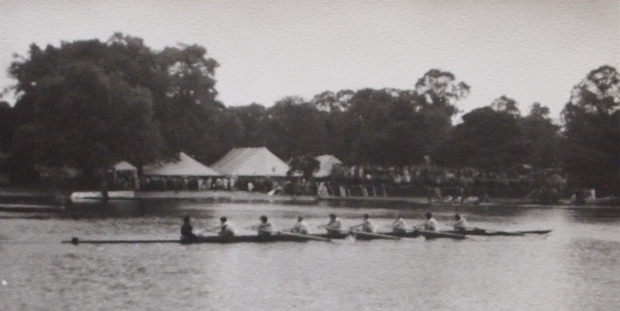
UUWBC eight at Serpentine Regatta in 1957. (Photo: Frances Bigg’s personal collection.)
Meanwhile the Stuart Ladies four had won at Weybridge Ladies Regatta, the Women’s ARA Barnes and Mortlake Events and the Women’s ARA Fours Regatta, as well as in an eight at the Alpha Women’s RC Regatta.
Out at the Championships
Accommodation and facilities
The British team (men and women) were hugely impressed by “the magnificent boathouses and associated premises [that] were all newly constructed at a cost of £85,000 paid for by TOTO the state sports lottery” (Almanack) at the rowing course which had been built in 1935.
Barbara Benzing, writing in The Oarswoman, added that for her crew, “The outstanding memory… is the Sports School where competitors of all nationalities were encamped. An ultra modern building set in the middle of a park with the rowing course one mile away, a huge swimming pool across the road, two stadiums, many running tracks and football pitches… In the school the dormitories, showers and drying rooms all helped to make life very easy for competitors between hard training spins. Food, which is always interesting, was very plentiful at each of the three meals provided daily. This we felt was most important in the last week of training, for eating the correct food is something that cannot be demanded at home.” The complex also had a cinema where the teams were shown a film about the previous year’s Championships in Bled and another one – which was notable for being in colour – about Henley Royal Regatta.
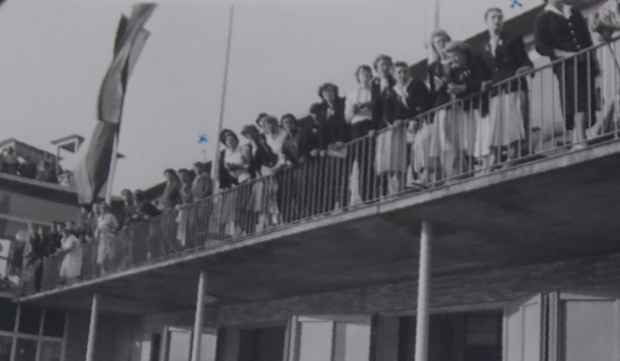
The GB team and supporters on the viewing balcony on top of the boathouse at the Wedau course. From left to right between the blue crosses: Sheilah Beningfield, Marrian Yates, Gill Perry, Barbara Philipson, Joan Hiller, Bridget Gilbert, Deirdre Holford, Valerie Dolman, Grace Errington, Jean Gilbert, Barbara Benzing, Julie Osborne, Josie Chilvers. (Photo: Pauline Chucher’s personal collection.)
The team arrived in Duisburg on Monday, 19 August, tired after a long boat and train journey, but racing in the three-day regatta didn’t start until Friday, 23 August. Both GB crews only had straight finals, although they seem not to have known that this would be the case in advance as Frances Bigg recorded that, “We were shocked to find we were the only western crew in the VIIIs – only 4 countries all told, therefore no heats. There were originally seven IVs entries but one scratched therefore no heat.”
This meant they had five full days to train before their races.
And then it all went wrong for the eight
Unfortunately, Frances Bigg, who was one of the strongest and most experienced rowers (she had also been in the eight that raced at the test event in Copenhagen in 1953), who was in the five seat of the eight, was taken ill on the journey to Germany and went straight to bed with flu-like symptoms as soon as they arrived.
In fact, she had contracted polio, a disease which today exists only in Pakistan, Afghanistan and Nigeria, according to the World Health Organisation, but was rife back then in the UK, which only started immunising against it the following year. Those who are infected can pass it on through poor hygiene, and public transport was a prime location for its transmission.
It is essential that anyone with polio doesn’t exercise as this can increase the chances that they are severely paralysed. Fortunately (and it’s a relative term), Frances felt so ill that rowing was completely out of the question. Her crew mate Dorothea Newman, who had worked with polio victims as a physiotherapist and so was familiar with the subtle differences in symptoms between the disease and ordinary flu, had her suspicions, and made absolutely sure Frances did nothing but rest.
Had the German doctors actually recognised that this was what she had, it’s likely they would have stopped the entire British team from racing, just in case they were incubating it too. But they didn’t, and through a combination of being careful and finding Frances a room on her own for most nights, no one else caught it.
For the crew, there was at least a solution at hand as the team had traveled to Duisburg with subs for both the eight and the four so Bridget Gilbert was put into the three seat instead of Gill Perry, who was moved to seven, with the original seven, Deirdre Holford, going to five to take Frances’s place in the ‘engine room’. Frances later recorded that, “Bridget rowed like a Trojan apparently, and Gill made an excellent seven.”
Although losing her may not actually have affected the results, the crew certainly missed her, not only for her physical strength but also because as its Captain she, “Had been a major driving force in the preparation of the crew”, according to Amy Gentry writing later in The Oarswoman.
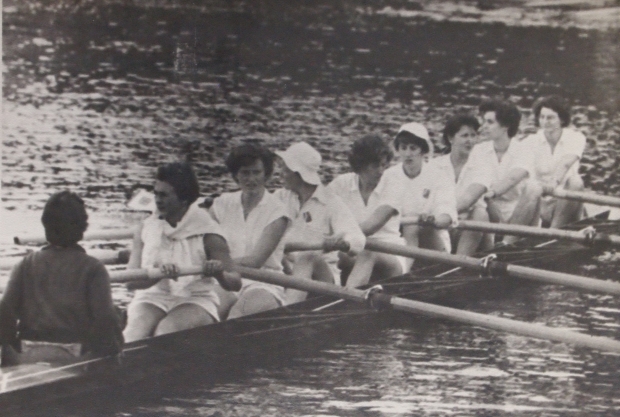
The 1957 GB women’s eight that actually raced. (Photo: Frances Bigg’s personal collection.)
For the record the eight that represented GB at the 1957 Women’s European Rowing Championships was:
B: Marrian Yates
2: Sheila Beningfield
3: Bridget Gilbert
4: Valerie Dolman
5: Deirdre Holford
6: Barbara Philipson
7: Gill Perry
S: Dorothea Newman
Cox: Joan Hiller
Training on the course
Although bed-bound, Frances got frequent updates from the crew, and was told that, “Mr Harry had a rubber motorised dinghy to coach from (he could go at a hell of a lick).”
Results and analysis
On finals day there was a strong cross tail wind at the start.
The eight came fourth out of four, finishing some 13 seconds behind (East) Germany who were in third place behind the winners Russia and silver medalists Romania. The first three crews finished within four seconds of each other. The GB crew was 17.1 seconds behind Russia who set a new record. “They didn’t lose contact with the other three until about 400m but then dropped back,” Frances wrote afterwards.
Frances was pragmantic about her absence, writing, “I’m afraid Mr Harry was very disappointed – what would have happened if it had been a head wind – and I had been in it? An interesting speculation.” But a later pencil annotation adds, “Five seconds better if very lucky. Certainly not more,” which seems very reasonable.
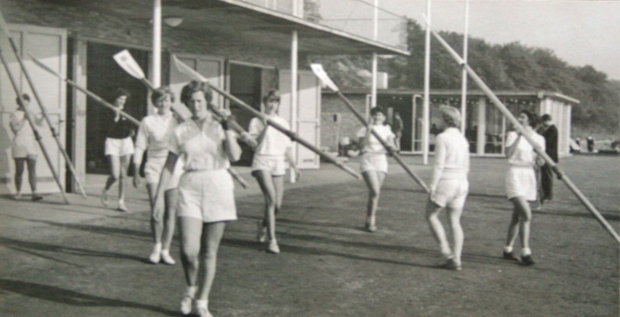
The crew get ready to go out for their race. (Photo: Frances Bigg’s personal collection.)
The four was fifth out of six after passing the half way mark in fourth place. They beat France by nearly 11 seconds but were 7.3 seconds down on the Danes who had rowed through them to take fourth. As in the eights, the medals went to the USSR (17.3 seconds ahead of GB), Romania and Germany, with Russia also setting a new record.
Russia, in fact, won every event again, setting new records in the eights, fours and quads. The unidentified writer of a report on the Championships in The Oarswoman commented that, “It was interesting to note that in many of their races the Russians did not lead at the half way mark but were much faster over the second half of the course.” However, this analysis is not supported by the actual times: in the seven races in which USSR competed, they won them all, and were leading at half way in all but one (the final of the singles where the USSR sculler, Emilia Kukhina was 0.2 sec down on the Austrian Eva Sitka at half way, though she went on to beat her by 1.4 sec).
The Australian sculler Stuart ‘Sam’ Mackenzie, who lived in the UK for many years and won the Diamond Sculls at Henley Royal regatta on numerous occasions, and was out at the Championships, commented on the two British crews’ performances in the September 1957 issue of Rowing magazine.
The English eight were a poor last and it was obvious they lacked both style and strength. It was bad luck they were missing their best member, who was ill. Still, I feel one member would not compensate for the distance they were behind.
“The other English crew was a happy and determined little four. They put up a great fight rowing at 42 all the way, but in the fast conditions they were too short forward and never got their work on effectively. The Russian crews all looked very much the same and with their style they had fitness which was of equal importance. I was told by their interpreter that they start two months before the rowing season begins with physical exercises, and keep it up as well as rowing during the season.
The contrast between his damning summary about the eight and his compliments about the four should be taken in the context that, “The Stuarts got on with Mackenzie; UU did not,” according to Pauline Baillie Reynolds, a Reading University WBC oarswoman who was a spectator at Duisburg in 1957 and went on to represent GB five times as part of the United Universities crews of the early 1960s, a sentiment also noted by Frances Bigg.
Neither Pauline nor others who felt that Mackenzie’s piece was biased were in any way detracting from the four’s performance, which was particularly admirable given their light weight as there was a headwind on finals day. As Amy Gentry wrote in The Oarswoman, the four, “Did remarkably well to gain fifth place out of the six crews in the final, due, I would say, to their fitness produced by training four times a week from last Autumn to this August.” Barbara Benzing, the four’s most experience member, is actually less up-beat. “We raced quite a lot in this country and we did well, but out there [at the Championships] we were outclassed as it happened. Just weren’t good enough,” she says, although adds, “I think the standard had gone up [since 1954].”
In some ways, a more worrying feature of the Championships than the level of the British performance was the lack of entries overall (30, compared with 34 in 1954), which could have endanger the very existence of this newly-created event. Amy Gentry speculated that, “The high standard of crews from Eastern Europe is frightening off crews from other countries, which is a tremendous pity… their high standard should be a challenge to be accepted, not avoided.” However, she acknowledged that there was also little point in sending lambs to the slaughter (especially given the costs of doing so). “These Championships must not fail for lack of support but, and I hate having to say this, we would to wise to keep our representation to smaller units until the rise in standard [in our women’s rowing] is sufficiently pronounced for us to look for an eight again.” Her advice, which has been echoed many times over the years since (remember the value of learning from history and avoiding the constant reinvention of the wheel?) was not, in fact, heeded, with an eight being sent to four of the next seven Championships at which GB was represented.
Amy’s report in The Oarswoman concluded with her saying, “I desperately long to see Great Britain win some of these events before I am too old, and too poor, to be there when they do!” Sadly, she never did as she died just before the 1976 Olympics, long before GB women’s first gold medal was won by Beryl Crockford and Lin Clark in the Lightweight double in 1985.
Funding
The cost of sending the two crews to the Championships was mostly met by the Women’s ARA from their International Fund. The Oarswoman records two painfully small initiatives that contributed to this; “The sweepstake on the 1957 Derby produced £39.7.5 for the International Fund. The raffle of a colour print of Henley by Mr K Vernon (presented to the Association by Mrs K Vernon) made £7.12.6. We send our warmest thanks to all Clubs which have helped in the sale of tickets and have achieved these results.”
Fun stuff and international relations
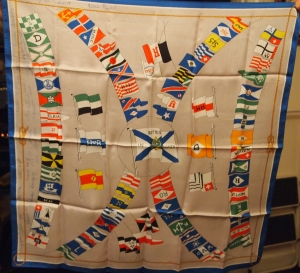
Dorothea Newman still has the silk scarf she was presented with, signed by many of the other competitors. (Photo: © Helena Smalman-Smith.)
The social and ceremonial aspects of the Championships almost dominated the programme of races (of which there were only eleven): on the Saturday evening (yes, the night BEFORE the finals) there was a boat trip for all the teams to see a firework display entitled ‘Fire on the Rhine’. After the finals and the closing ceremony on the Sunday there was a dance at the town hall where each competitors was presented with a silk scarf, and the following day there was a tour of the port with tea after at Duisburger Ruderverein (Duisburg Rowing Club).
On the way to the fireworks the British team shared a coach with the Russians who got everyone singing, with folk songs traded in a sort of multi-lingual sing-off. As Barbara Benzing observed, “At least here we could hold our own.” When the Brits struck up ‘There is a tavern in the town’ (No, I don’t know that one either – maybe it was better-known back then? – Ed.) everyone was amused to discover the Russians knew the tune and joined in with their own words.
Today, international competition is entirely about winning, but back in the 1950s, just 12 years after the end of the Second World War and with the boom in foreign holidays only just getting going, it is understandable that even Amy Gentry felt that there was more to the Women’s Championships than the racing. “Surely these meetings between women interested in the same sport should serve a double purpose,” she wrote in The Oarswoman, “Not only to foster a feeling of friendly rivalry, but also to help all of us to understand each other and our ways of life.”
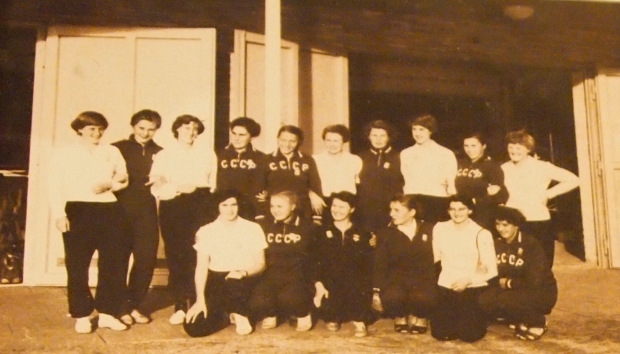
It caused “a little bit of a stir” when the British and Russian eights posed for this photo and Dorothea and the Russian’s stroke exchanged addresses so that they could post on copies of the photo later. (Photo: Dorothea Cockett’s personal collection.)
Dorothea Newman, who spoke good German, was able to get talking to some of the others crews, although when it came to the Russians “it was a silent kind of thing”. The cox of the Russian quad gave her one of her white hair ribbons as a parting gift, and two of their eight gave her a half-used bottle of perfume. Writing in The Oarswoman, she said, “The fact that we were not successful in our rowing did not in any way effect our relationships with other competitors.”
She became particularly friendly with Cornelia Pap, the Hungarian sculler who won the bronze medal, and who “almost apologetically explained about their training camps”. After the Championships, Dorothea, Pauline Baillie Reynolds, Barbara Philipson and Bridget Gilbert stayed on in Duisburg to watch the men’s racing as guests of Germania Ruderverein. Evading her minder, Pap joined them and the five women had a fun time staying on a converted Rhine steamer which was moored outside the club and was used in term time as a dormitory for young men training to become merchant seamen. There seemed to have been a fair amount of dancing at the club in the evenings as well as beer drinking. Dress standards were, however, maintained to the highest levels even when doing the touristy bit.
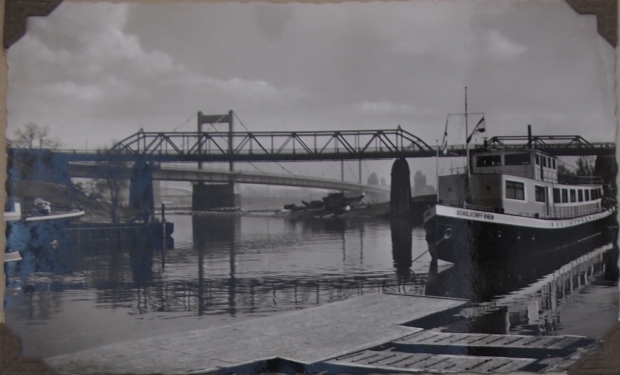
The old steamer outside Germania RV where four of the UU contingent stayed with Cornelia Pap during the men’s Championships. (Photo: Pauline Churcher’s personal collection.)
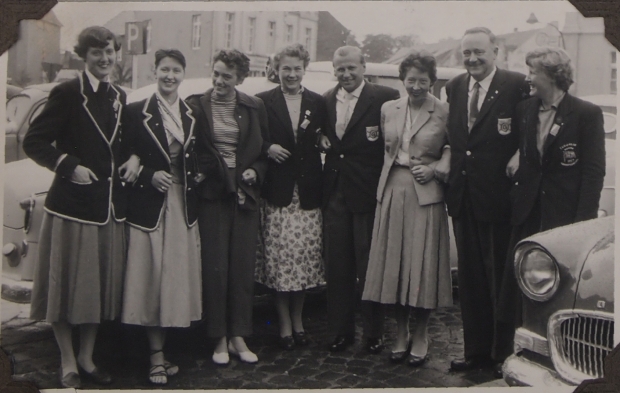
From Left: Pauline Baillie Reynolds, Bridget Gilbert, Anita Gieven (German host), Dorothea Newman, Gunther Gieven (German host), Anneliese Maassen (German host), Herr Heckes (German host), Barbara Philipson. (Photo: Pauline Churcher’s personal collection.)
